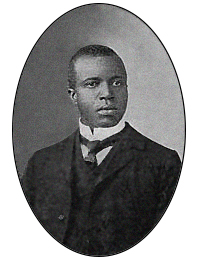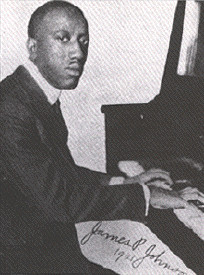Related Research Articles

Ragtime, also spelled rag-time or rag time, is a musical style that had its peak from the 1890s to 1910s. Its cardinal trait is its syncopated or "ragged" rhythm. Ragtime was popularized during the early 20th century by composers such as Scott Joplin, James Scott and Joseph Lamb. Ragtime pieces are typically composed for and performed on piano, though the genre has been adapted for a variety of instruments and styles.

Scott Joplin was an American composer and pianist. Dubbed the "King of Ragtime", he composed more than 40 ragtime pieces, one ragtime ballet, and two operas. One of his first and most popular pieces, the "Maple Leaf Rag", became the genre's first and most influential hit, later being recognized as the quintessential rag. Joplin considered ragtime to be a form of classical music meant to be played in concert halls and largely disdained the performance of ragtime as honky tonk music most common in saloons.

Ferdinand Joseph LaMothe, known professionally as Jelly Roll Morton, was an American ragtime and jazz pianist, bandleader, and composer of Louisiana Creole descent. Morton was jazz's first arranger, proving that a genre rooted in improvisation could retain its essential characteristics when notated. His composition "Jelly Roll Blues", published in 1915, was one of the first published jazz compositions. He also claimed to have invented the genre.
Johnny Dodds was an American jazz clarinetist and alto saxophonist based in New Orleans, best known for his recordings under his own name and with bands such as those of Joe "King" Oliver, Jelly Roll Morton, Lovie Austin and Louis Armstrong. Dodds was the older brother of drummer Warren "Baby" Dodds, one of the first important jazz drummers. They worked together in the New Orleans Bootblacks in 1926. Dodds is an important figure in jazz history. He was the premier clarinetist of his era and, in recognition of his artistic contributions, he was posthumously inducted into the Jazz Hall of Fame. He has been described as "a prime architect in the creation of the Jazz Age."

James Price Johnson was an American pianist and composer. A pioneer of stride piano, he was one of the most important pianists in the early era of recording, and like Jelly Roll Morton, one of the key figures in the evolution of ragtime into what was eventually called jazz. Johnson was a major influence on Count Basie, Duke Ellington, Art Tatum, Thelonious Monk, and Fats Waller, who was his student.
General Records was a small American record label during the late 1930s and early 1940s. Its most notable releases are piano solos recorded by Jelly Roll Morton in December 1939 late in his career.

Ella and Louis is a studio album by Ella Fitzgerald and Louis Armstrong, accompanied by the Oscar Peterson Quartet, released in October 1956. Having previously collaborated in the late 1940s for the Decca label, this was the first of three albums that Fitzgerald and Armstrong were to record together for Verve Records, later followed by 1957's Ella and Louis Again and 1959's Porgy and Bess.
"King Porter Stomp" is a jazz standard by pianist Jelly Roll Morton, first recorded in 1923. The composition is considered to be important in the development of jazz. It became a hit during the swing era, when it was recorded by Benny Goodman.

The soundtrack to the film Pretty Baby used many local New Orleans musicians playing in the jazz, ragtime, and blues style of the city in the early 20th century. An LP album of the soundtrack, also entitled Pretty Baby, was issued in 1978 on ABC Records. The film is named after the song "Pretty Baby" by Tony Jackson.

"Magnetic Rag" is a 1914 ragtime piano composition by American composer Scott Joplin. It is significant for being the last rag which Joplin published in his lifetime, three years before his death in 1917. It is also unique in form and in some of the musical techniques employed in the composition.
In music and jazz harmony, the Stomp progression is an eight-bar chord progression named for its use in the "stomp" section of the composition "King Porter Stomp" (1923) by Jelly Roll Morton. The composition was later arranged by Fletcher Henderson, adding greater emphasis on the Trio section, containing a highly similar harmonic loop to that found in the Stomp section. It was one of the most popular tunes of the swing era, and the Stomp progression was often used.

"Frog Legs Rag" is a classic rag composed by James Scott and published by John Stillwell Stark in December 1906. It was James Scott's first commercial success. Prior to this composition Scott had published marches. With "Frog Legs Rag", Scott embarked upon a career as a successful and important ragtime songwriter.
"Black Bottom Stomp" is a jazz composition. It was composed by Jelly Roll Morton in 1925 and was originally entitled "Queen of Spades". It was recorded in Chicago by Morton and His Red Hot Peppers, for Victor Records on September 15, 1926.

Air Lore is an album by the improvisational trio Air featuring Henry Threadgill, Steve McCall, and Fred Hopkins performing compositions by Jelly Roll Morton and Scott Joplin. It was reissued on compact disc by Bluebird/RCA in 1987 and included in the eight-CD box set, Complete Novus and Columbia Recordings of Henry Threadgill and Air on Mosaic Records.

The period from the end of the First World War until the start of the Depression in 1929 is known as the "Jazz Age". Jazz had become popular music in America, although older generations considered the music immoral and threatening to cultural values. Dances such as the Charleston and the Black Bottom were very popular during the period, and jazz bands typically consisted of seven to twelve musicians. Important orchestras in New York were led by Fletcher Henderson, Paul Whiteman and Duke Ellington. Many New Orleans jazzmen had moved to Chicago during the late 1910s in search of employment; among others, the New Orleans Rhythm Kings, King Oliver's Creole Jazz Band and Jelly Roll Morton recorded in the city. However, Chicago's importance as a center of jazz music started to diminish toward the end of the 1920s in favor of New York.
"Wolverine Blues" is an early jazz standard by Jelly Roll Morton with lyrics by the brothers Benjamin Franklin "Reb" Spikes and John Curry Spikes.
"Grandpa's Spells" is an early jazz song by Jelly Roll Morton. He recorded it for Gennett Records, Richmond, Indiana on 18 July 1923 along with "Kansas City Stomp" and "Wolverine Blues". It was released in 1924.
References
- ↑ Jasen, David A.; Jones, Gene (11 October 2013). Black Bottom Stomp: Eight Masters of Ragtime and Early Jazz. Routledge. p. 149. ISBN 978-1-135-34928-8.
- ↑ Brown, Sterling Allen (1976). Sterling A. Brown: a UMUM tribute. Black History Museum UMUM Publishers. p. 80.
- ↑ "Grammy Hall of Fame". Recording Academy. Retrieved 7 January 2019.
- 1 2 Jasen, David A.; Jones, Gene (2013). Black Bottom Stomp: Eight Masters of Ragtime and Early Jazz. Routledge. p. 149. ISBN 978-1-135-34928-8.
- ↑ Laird, Ross (1995). Tantalizing Tingles: A Discography of Early Ragtime, Jazz, and Novelty Syncopated Piano Recordings, 1889-1934 . Greenwood Publishing Group. p. 110. ISBN 978-0-313-29240-8.